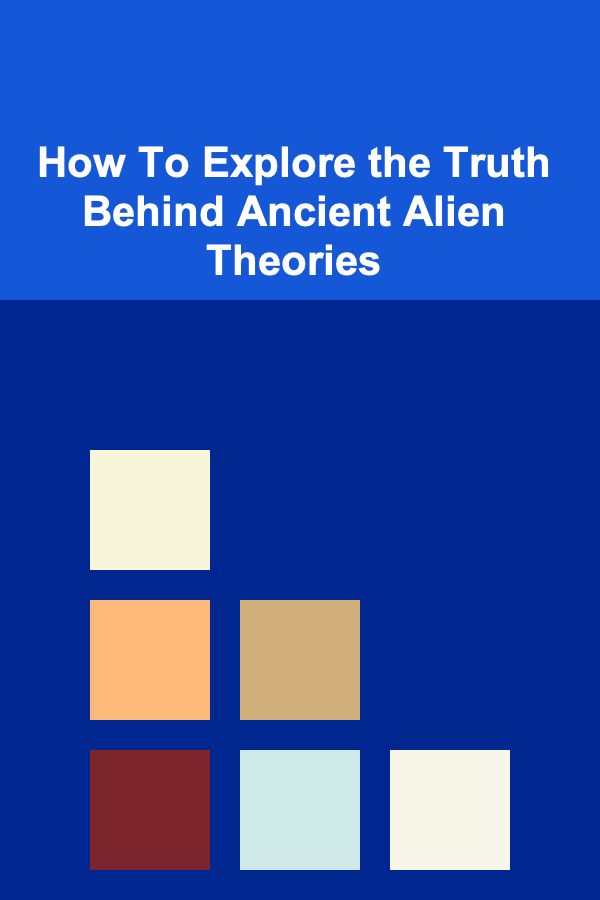
How To Explore the Truth Behind Ancient Alien Theories
ebook include PDF & Audio bundle (Micro Guide)
$12.99$9.99
Limited Time Offer! Order within the next:

The idea that extraterrestrial beings may have visited Earth in ancient times has intrigued people for decades. Known as the "Ancient Astronaut Theory" or "Ancient Alien Theory," this concept suggests that ancient civilizations were either influenced by or directly visited by advanced extraterrestrial life. The theory spans a range of claims, from sightings of UFOs in ancient times to the suggestion that alien technologies helped build monumental structures like the Great Pyramids of Giza or Stonehenge. The popularity of such ideas has soared, thanks in part to media, books, and documentaries like Ancient Aliens on the History Channel.
In this article, we will explore how to investigate the truth behind ancient alien theories by delving into the origins of these claims, examining key evidence, critically analyzing the arguments put forth by proponents, and understanding the broader implications of these ideas.
Understanding Ancient Alien Theories
Ancient alien theories propose that extraterrestrial beings visited Earth in prehistoric or ancient times, influencing the development of human civilization in ways that are either not fully understood or outright mysterious. Proponents of this theory suggest that these visitors may have shared knowledge or technologies with early human societies, enabling them to achieve extraordinary feats. Some of the most prominent figures associated with these ideas include Erich von Däniken, who authored Chariots of the Gods? in 1968, and Giorgio A. Tsoukalos, a host of the Ancient Aliens TV series.
These theories encompass a wide array of ideas, including:
- Ancient Artwork: Some proponents point to ancient artwork depicting beings that resemble modern descriptions of aliens, such as the "Chariots of the Gods" artwork and cave paintings that seem to depict humanoid beings with large heads and big eyes.
- Technological Anomalies: The construction of megalithic structures like the Egyptian pyramids, Stonehenge, and the Nazca Lines in Peru are often cited as evidence that ancient humans couldn't have built such wonders without help from advanced alien civilizations.
- The Sumerian Mythology: Ancient texts like the Epic of Gilgamesh and the Sumerian tablets tell of gods who descended from the skies, sometimes described in ways that seem strikingly similar to extraterrestrial beings.
The Origins of Ancient Alien Theories
The idea of ancient extraterrestrial visitors is far from new. Ancient cultures often attributed extraordinary knowledge, technological prowess, or divine powers to gods who descended from the heavens, which some modern theorists interpret as evidence of extraterrestrial influence.
Early Roots in Mythology
Many ancient civilizations, from the Mesopotamians to the Egyptians, had deities associated with the sky, often described as descending from above to teach humanity essential skills. The Sumerians, for instance, spoke of the Anunnaki, a race of gods who were said to have come from the sky to teach humanity writing, agriculture, and metallurgy. These myths, when viewed through a modern lens, are often interpreted by ancient astronaut theorists as evidence of extraterrestrial intervention.
Erich von Däniken and the Modern Theory
The modern popularity of the ancient alien hypothesis can be traced back to Erich von Däniken's 1968 book, Chariots of the Gods? Von Däniken suggested that various ancient wonders, such as the pyramids of Egypt and the Nazca Lines, were either built or influenced by extraterrestrials due to their complexity and the lack of clear technological explanations for their construction at the time. His ideas, while controversial, sparked widespread interest in the possibility of extraterrestrial influence on Earth's ancient civilizations.
The Rise of Pop Culture Influence
With the rise of pop culture in the late 20th century, particularly through documentaries, books, and TV shows like Ancient Aliens, the ancient astronaut theory gained traction. These media outlets often portray ancient sites and unexplained phenomena through the lens of extraterrestrial involvement, feeding into public fascination with the unknown.
Key Evidence Cited by Ancient Astronaut Theorists
Proponents of ancient alien theories often point to a variety of archaeological sites, artifacts, and historical records as evidence that extraterrestrial beings visited Earth in ancient times. Here, we'll examine some of the most commonly cited pieces of evidence.
Megalithic Structures
Many ancient structures are cited as proof that extraterrestrial beings helped humans achieve feats of engineering and construction that were otherwise unimaginable for ancient cultures. Some examples include:
- The Pyramids of Giza: The sheer scale and precision of the Great Pyramid of Giza, which is aligned with incredible accuracy to true north and built with massive stone blocks, has led some to suggest that aliens played a role in its construction. The idea is that the technological capability required to build such a structure was beyond the means of ancient Egyptians.
- Stonehenge: The transportation of massive stones and their precise arrangement at Stonehenge has also led to speculations about extraterrestrial involvement. The exact purpose of the site remains unclear, fueling ideas that advanced beings might have helped construct the monument.
- The Nazca Lines: The Nazca Lines in Peru are a series of enormous geoglyphs carved into the desert floor. Their large scale and the fact that they are best viewed from the air has led to theories that they were created with the help of extraterrestrial beings who instructed the ancient Nazca people.
Ancient Texts and Artifacts
Ancient texts and artifacts are often interpreted as references to extraterrestrial beings. Some of the most commonly cited examples include:
- The Sumerian Tablets: The Sumerians, one of the earliest known civilizations, left behind texts that describe gods descending from the sky. The Anunnaki, in particular, are often viewed by ancient astronaut theorists as aliens who visited Earth to guide human development.
- The Mahabharata and the Ramayana : Ancient Hindu texts like the Mahabharata and Ramayana contain descriptions of gods flying in "vimanas," which some have interpreted as ancient spacecraft. These flying machines are often depicted as having great power and advanced technology.
- Ancient Art Depictions: Some ancient artwork, including cave paintings, sculptures, and carvings, is argued to depict beings with otherworldly features, such as large heads and eyes, which resemble modern depictions of aliens.
Unexplained Technological Knowledge
Certain ancient technologies and achievements, such as the creation of advanced tools, building techniques, or astronomical knowledge, are cited as evidence that extraterrestrial beings played a role. For example, the Mayans' sophisticated understanding of the stars and the construction of complex observatories has led to suggestions that their knowledge could have come from extraterrestrial sources.
Critically Analyzing the Evidence
While the ancient astronaut theory is popular in some circles, it is essential to critically analyze the evidence presented by its proponents. Many mainstream scientists and archaeologists remain skeptical of these ideas, offering alternative explanations that do not require extraterrestrial intervention.
Alternative Explanations for Megalithic Structures
The construction of megalithic structures can be explained through the ingenuity and determination of ancient peoples. For instance, the pyramids of Egypt, while undoubtedly impressive, are not as mysterious as some suggest. Archaeologists have shown how the Egyptians could have used simple tools, ramps, and manpower to construct these massive structures.
Similarly, Stonehenge is believed to have been built using a combination of levers, sledges, and sheer human effort. The idea that extraterrestrials were required to build these monuments is not supported by archaeological evidence.
Ancient Texts and Mythology
The descriptions of gods descending from the heavens are common in many ancient mythologies and can be seen as symbolic representations of divine power, not literal accounts of alien visitation. Such texts are more likely to reflect human attempts to understand the mysteries of the world, rather than describing extraterrestrial contact.
Human Ingenuity and Evolution
Humanity's capacity for innovation should not be underestimated. Early civilizations were capable of astonishing feats of engineering, mathematics, and art. Rather than attributing their successes to aliens, it is more plausible that these accomplishments were the result of human creativity, trial and error, and long periods of development.
The Broader Implications of Ancient Alien Theories
The ancient astronaut theory raises profound questions about humanity's place in the universe and our relationship with other potential intelligent life forms. The idea that extraterrestrials influenced ancient civilizations taps into humanity's deepest fears and hopes about life beyond Earth. It suggests that we might not be as isolated as we once thought and that we may have received knowledge from other civilizations that could have shaped our history.
However, the popularity of ancient alien theories also speaks to broader issues of skepticism, the search for meaning, and our quest to understand the unknown. While the theory is controversial and often unsubstantiated, it reflects a human desire to explain the mysteries of our past and our place in the cosmos.
Conclusion
Exploring the truth behind ancient alien theories requires an open mind and a willingness to critically evaluate the evidence. While many of the claims made by proponents of the theory are intriguing, they often lack solid empirical evidence and can be explained by more plausible, Earth-bound explanations. As we continue to explore our planet's ancient past, it is essential to maintain a balance between curiosity, skepticism, and scientific inquiry to uncover the true story of humanity's history. Whether or not extraterrestrial beings ever visited our ancestors, the pursuit of knowledge and understanding remains one of humanity's most enduring qualities.

Creative Affordable Home Organization Ideas You Can Try This Weekend
Read More
How to Create a Functional Mudroom for Your Family
Read More
How to Manage Your Finances as a Freelancer or Entrepreneur
Read More
How To Master Indoor Plant Care
Read More
Understanding Social Security and Early Retirement: A Comprehensive Guide
Read More
How to Conduct a Comprehensive Competitor Analysis
Read MoreOther Products

Creative Affordable Home Organization Ideas You Can Try This Weekend
Read More
How to Create a Functional Mudroom for Your Family
Read More
How to Manage Your Finances as a Freelancer or Entrepreneur
Read More
How To Master Indoor Plant Care
Read More
Understanding Social Security and Early Retirement: A Comprehensive Guide
Read More